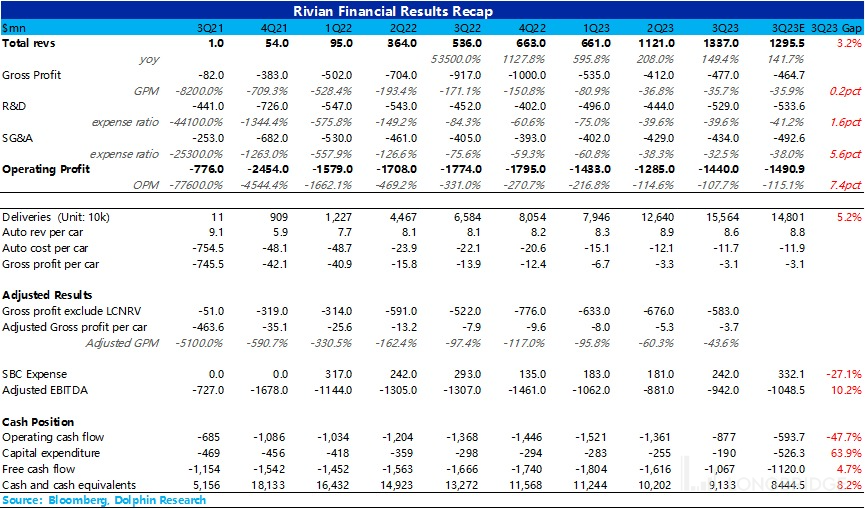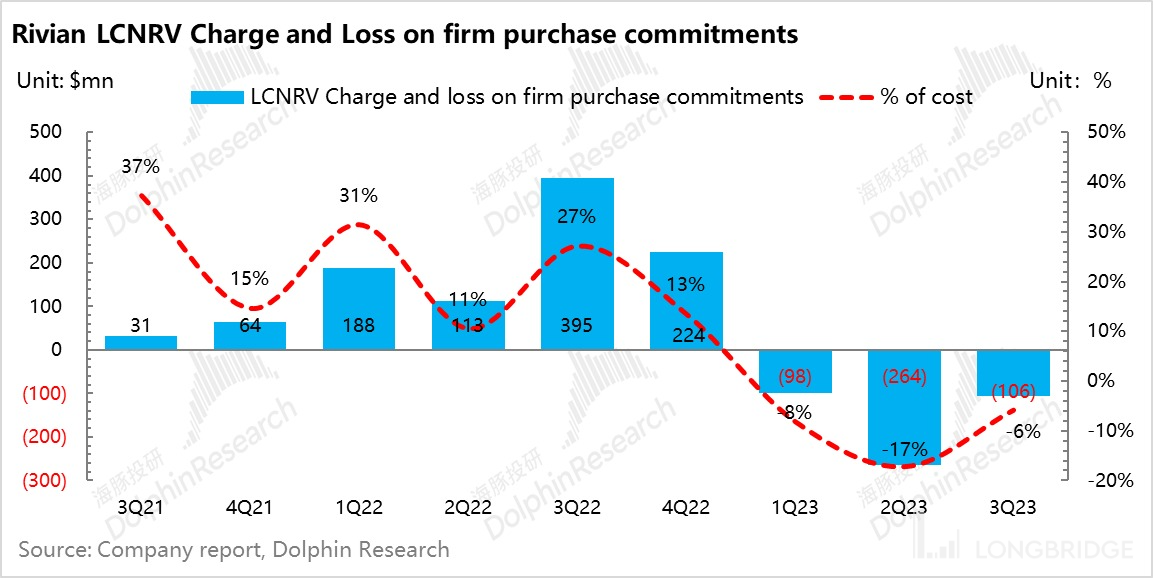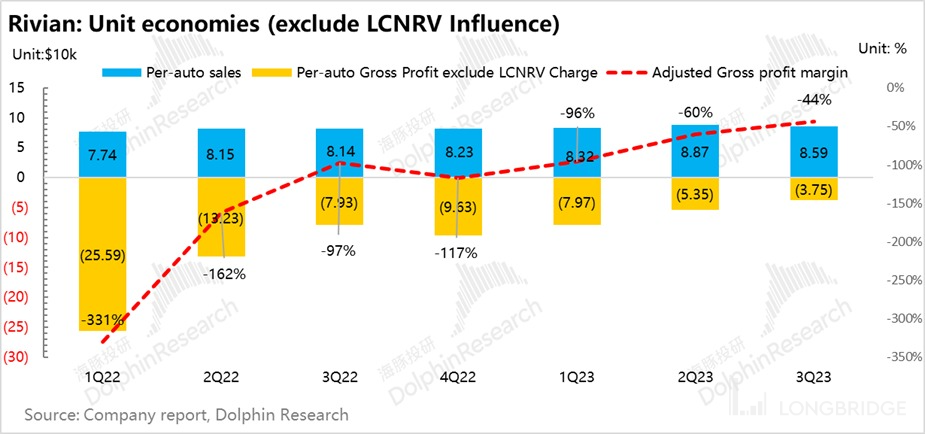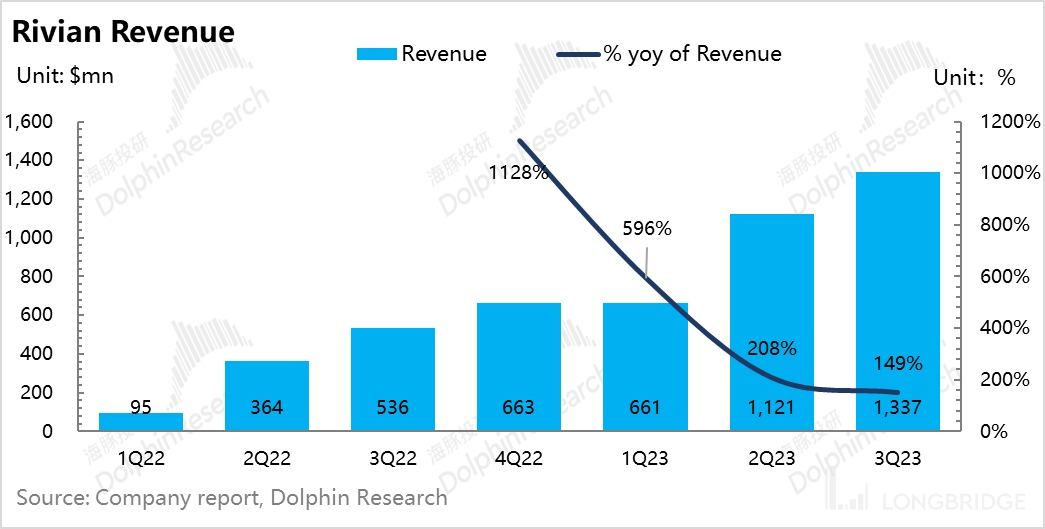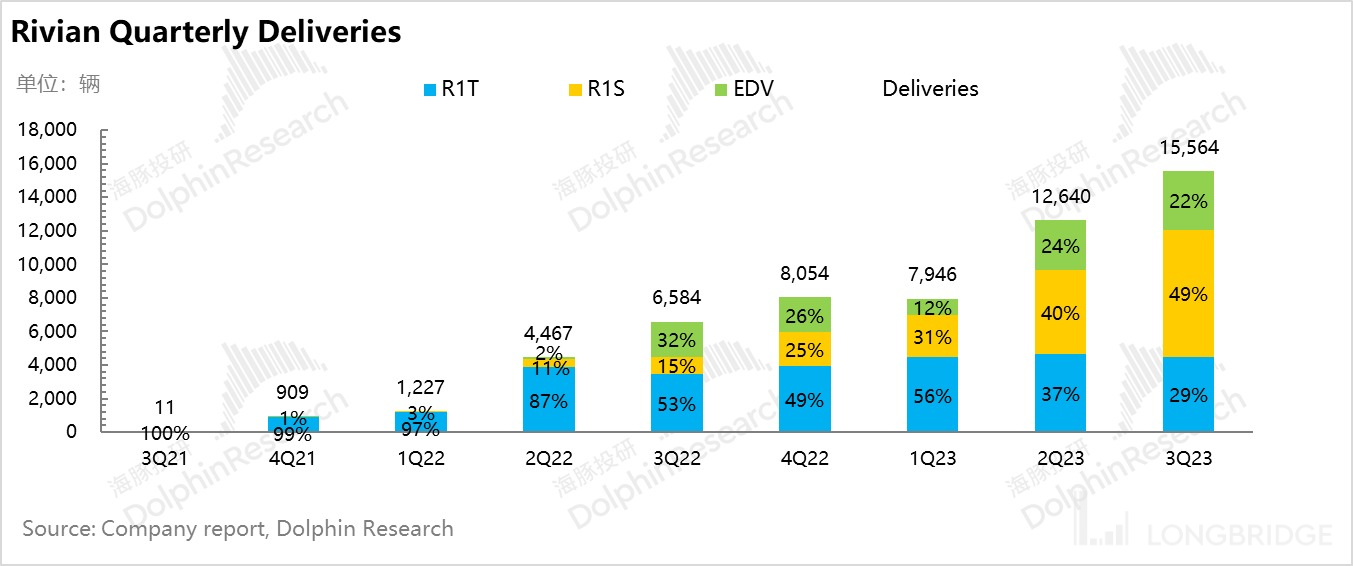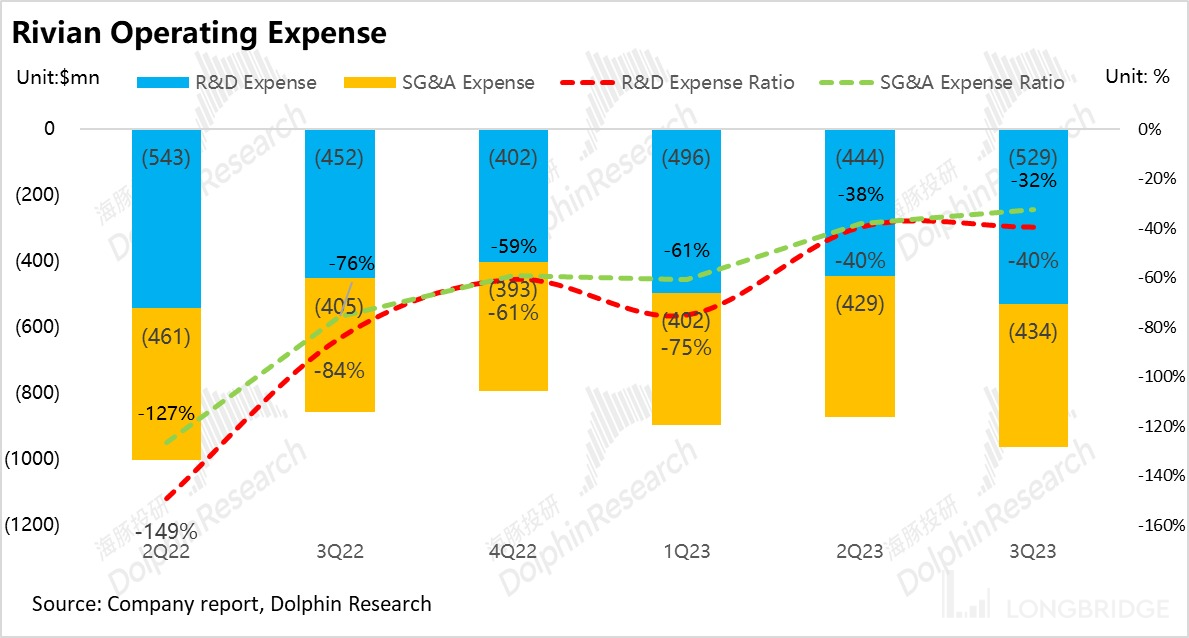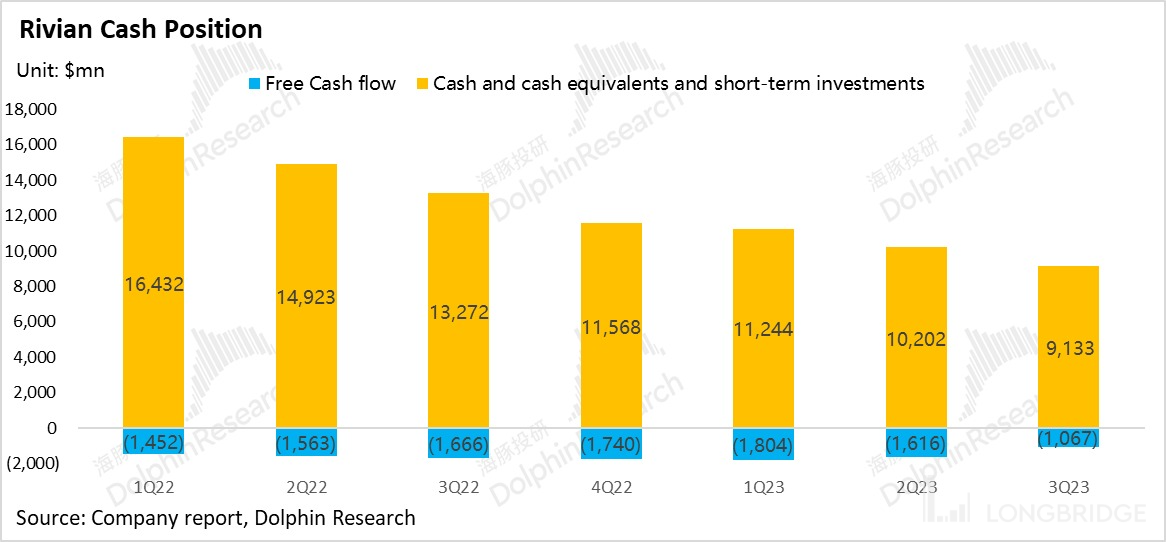Rivian exceeds expectations again, is there hope for the "Tesla killer" to cross the life-or-death line?
Rivian released its third-quarter earnings report after the US stock market closed on November 7, 2023. Let's take a look at the key information:
1)Continued marginal improvement in gross margin: The gross margin continued to improve this quarter. Excluding the impact of inventory valuation and contract losses, the gross margin increased from -60.3% in the second quarter to -43.6% in the third quarter. This was mainly due to the reduction in amortized costs and raw material costs resulting from increased production, as well as the cost reduction brought about by vertical supply chain integration and battery material substitution.
2)Annual Guidance continues to increase: Rivian's full-year production guidance for 2023 has been raised from 52,000 vehicles to 54,000 vehicles. The adjusted EBITDA for the full year has been adjusted from -4.2 billion US dollars to -4 billion US dollars, and capital expenditures have been adjusted from 1.7 billion US dollars to 1.1 billion US dollars. This reflects the management's commitment to improving the gross margin of the R1 and RCV platforms and controlling expenses to achieve positive gross margin in 2024 and improve free cash flow levels.
3)Operating expenses remain rigid: The leverage of operations was not significant this quarter, and operating expenses remained relatively rigid. In terms of research and development investment, Rivian needs to achieve cost reduction through electrification vertical integration and next-generation technology platforms, as well as alleviate supply chain issues and increase production. This is also the focus of Rivian's current layout, and the rigidity of research and development expenses can be understood.
4) Cash flow remains a major issue: Although free cash flow improved in the third quarter due to operational improvements and expense control, Rivian still faces challenges of negative free cash flow. The time window for Rivian is running out, and at most, it can only last until 2025 before a cash shortfall occurs.
Dolphin Research's overall view:
For American new energy vehicle companies like Rivian that continue to burn money and sustain losses, investors are most concerned about the increase in Rivian's production volume and the marginal changes and expectations of gross margin, in order to find signs of operational improvement.
This quarter, Rivian's delivery volume exceeded expectations, and the company continued to reduce losses in gross margin. In addition to the impact of inventory devaluation and the reversal of purchase commitment losses (LCNRV) due to increased production, the decrease in per-vehicle costs brought about by increased production and cost reduction through technology played a significant role.
However, unlike Tesla's previous strategy of "produce as much as you sell," Rivian still faces production capacity constraints and is still in the stage of sales driven by production capacity. The real explosion in production capacity will come with the mass production of the R2 platform model in 2026 (initial production capacity planning of 200,000 vehicles, priced at $40,000 to $60,000). Before that, the investment opportunity should be to wait for the price to drop low enough and look for a turning point in gross margin positivity. The management has set this time point in 2024.
Rivian's current cash flow can only support operations until 2025, which is not enough to complete the construction of the Georgia factory (for the production of the R2 platform). Therefore, the company will inevitably need to engage in another round of financing. However, the financial market has become increasingly stringent towards new electric vehicle companies that continue to burn through cash. At a time when sales and gross profit margins are under pressure, raising funds through additional financing will come at a high cost, and the market has not shown much confidence.
Therefore, the most important thing for Rivian at the moment is to improve the gross profit margins of the R1 and EDV models before the release of the R2 platform. The company aims to achieve positive gross profit margins by 2024, as stated in its plan. This will help gain the confidence of the capital market and secure financing to support the construction of the R2 platform, expand production capacity, and achieve a similar situation to Tesla's "Model 3/Y" moment.
Ⅰ. Continued Marginal Improvement in Gross Profit Margins
In the current quarter, Rivian continued to reduce losses, with the gross profit margin slightly improving by one percentage point to -35.7%, surpassing the market's expectation of -35.9%.
To understand Rivian's gross profit margin for vehicle manufacturing, it is necessary to clarify the company's understanding of inventory impairment and contract losses, which Rivian collectively refers to as "LCNRV".
As we know, due to Rivian's ongoing struggle with production capacity constraints, the negative impact of this situation includes:
1)The market value of previously purchased raw materials and components, such as batteries, may have changed significantly compared to the original purchase price.
2)Contract losses with suppliers due to failure to meet production targets.
3)Sales price reductions due to inventory obsolescence.
This situation is similar to the issues Dolphin Research has observed in tracking companies such as Xiaopeng, Li Auto, and NIO during their product iteration processes. It is not particularly surprising. Generally, when problems arise, the losses incurred are directly included in the cost of selling vehicles, affecting the gross profit margin of the current period's vehicle sales business.
However, the main problem is that Rivian's production capacity constraints have persisted for too long, leading to a significant amount of impairment in the past. Now that production is starting to ramp up, it has been discovered that the previous impairment was excessive, and the losses previously recognized have been reversed. At this stage, this reversal has added a disguise to the true gross profit margin situation.
Therefore, when observing Rivian's gross profit margin progress, Dolphin Research pays more attention to the company's true gross profit margin performance after excluding the impact of the reversal:
1)The balance of LCNRV awaiting reversal this quarter is 450 million (including 290 million for inventory impairment and 160 million for purchase commitment losses), compared to 560 million at the end of the previous quarter. This means that 100 million+ was reversed this quarter, which raised the gross profit margin from -36.8% in the second quarter to -35.7% in the third quarter. The reversal of LCNRV is mainly due to the increase in production volume and the decrease in sales costs.
2)However, if we exclude the impact of LCNRV accounting treatment, the gross margin for this quarter increased from -60.3% in the second quarter to -43.6% in the third quarter, reducing the per-vehicle gross loss from -$54,000 in the second quarter to -$38,000 in the third quarter.

From the breakdown of the economics of each vehicle (excluding the impact of LCNRV):
a) Average selling price per vehicle:
The average selling price per vehicle in the third quarter was $85,900, which is $2,800 lower than the second quarter. The average selling price per vehicle decreased compared to the previous quarter.
The main reason for the decrease is the contribution of regulatory credit revenue in the second quarter, which was almost zero in the third quarter. Excluding this factor, the average selling price in the third quarter was almost the same as the second quarter.
In addition, Rivian has not further reduced prices despite the price war led by Tesla in the US and the price cuts by Ford. This likely reflects the continued backlog of orders and the existing production capacity bottleneck. Rivian is still in the stage where sales are driven by production capacity, which is the opposite of Tesla's previous strategy of "produce as much as you can sell".
b) Per-vehicle cost:
The per-vehicle cost in the third quarter was $123,000, a decrease of $19,000 compared to the previous quarter. The main reasons are:
Continued improvement in per-vehicle depreciation cost: Due to the increase in sales and the dilution effect on factory costs, the per-vehicle depreciation cost decreased by $1,400 from $13,000 in the second quarter to $11,000 in the third quarter.
Reduction in per-vehicle variable costs: The per-vehicle variable costs increased by $3,400 from $109,000 in the second quarter to $105,000 in the third quarter.
a) Vertical supply chain integration + cost reduction in battery materials: After Rivian equipped its EDV models with self-developed and self-produced Enduro motors and replaced ternary batteries with LFP batteries, reducing the BOM by 35%, it continued to reduce costs by introducing Enduro motors and LFP batteries on the R1 platform.
b) Scale effect on the procurement side due to increased production.
c) Per-vehicle gross profit:
With a decrease in average selling price per vehicle of $2,800 and a decrease in per-vehicle cost of $19,000, although there is a gross loss of $38,000 per vehicle in the third quarter, the loss has continued to narrow compared to the second quarter. The adjusted gross margin (excluding the impact of LCNRV) has improved to -44%.

II. Can the gross margin turn positive?
For Rivian, it is still in the stage where sales are driven by production capacity. The real point of capacity explosion will be the mass production of R2 platform models in 2026 (with an initial production capacity plan of 200,000 vehicles and a price range of $40,000 to $60,000). Before that, the investment opportunity should be when the price is low enough.Looking for investment opportunities where the gross profit margin can turn positive, the management has set the target year as 2024.
Looking ahead to the fourth quarter and 2024, the main factors contributing to the continued improvement in gross profit margin are:
The delivery of the R1T high-capacity battery model in the fourth quarter, which is currently the electric pickup truck with the longest range in the market, will drive up the unit price.
The increase in average selling price (ASP) due to the delivery structure, with the management expecting the higher-priced R1S to account for 70% of the total in the long term.
Cost reduction through vertical integration:
a) Rivian's self-developed Enduro motor and LFP battery used in the EDV platform have saved 35% in material costs. The Enduro motor and LFP battery have also been introduced to the R1 platform, and the EDV platform has already achieved a positive contribution margin (excluding fixed costs). The management expects the R1 platform to achieve a positive contribution margin by the end of the year.
b) The second-generation electronic architecture upgrade in 2024 will bring about cost reduction (60% reduction in ECU quantity, 25% reduction in wiring harness length).
- Incremental growth due to increased production and gradual resolution of production bottlenecks: The increase in production will lead to the amortization of fixed costs and purchase premiums (the management expects R1 production to reach 85,000 units in 2024), as well as the removal of the impact of LCNRV as the production capacity issue is gradually resolved in 2024.
III. Continued growth in revenue and delivery volume
In the third quarter, Rivian achieved total revenue of $1.34 billion, a year-on-year increase of 149%, exceeding market expectations of $1.3 billion, mainly driven by higher-than-expected delivery volume.
In this quarter, Rivian delivered 15,600 vehicles, a year-on-year increase of 136%, exceeding market expectations of 14,800 vehicles. The market share of electric vehicles in the United States is also continuously increasing, from 2.4% in the first quarter to 3.9% in the third quarter.
The proportion of the higher-priced SUV R1S in the sales structure continued to increase, from 40% in the second quarter to 49% in the third quarter. With the introduction of the higher-priced R1T version with a larger battery capacity in the fourth quarter, it is expected to drive up the average selling price in the fourth quarter. The management expects the SUV R1S to account for 70% of the production proportion in the long term.
Rivian has raised its annual production target from 52,000 units to 54,000 units, taking into account one week of downtime in the fourth quarter and seasonal factors such as Christmas holidays. This implies a fourth-quarter production of 14,000 units, a 12% QoQ decrease compared to the third quarter, which will have a cyclical impact on Rivian's delivery volume in the fourth quarter.


IV. Rigidity of Operating Expenses
1) Research and Development Expenses: In this quarter, Rivian's research and development expenses reached $529 million, an increase of $85 million compared to the previous quarter, but lower than the market expectation of $534 million.
In terms of research and development investment, Rivian's investment rigidity can be understood. Rivian needs to achieve vertical integration in electrification and next-generation technology platforms to achieve cost reduction and alleviate supply chain issues, and increase production capacity. This is also the focus of Rivian's current layout.
Rivian currently has a certain level of vertical integration in electrification, achieving in-house development of key three-electric technologies, as well as self-assembly of battery modules and packs. However, the core battery cells are still purchased from Samsung.
Such vertical integration not only helps Rivian achieve cost reduction in technology, which has a significant impact on Rivian's target of positive gross margin in 2024, but also to some extent alleviates the shortage of the supply chain and promotes continuous increase in Rivian's production capacity.
However, in terms of autonomous driving layout, although Rivian has developed its own Driver+ system, its level of intelligence is only at L2. Compared to Tesla's self-developed algorithm chips and closed-loop formed by the self-built supercomputing center for autonomous driving, there is still a huge gap.
2)Sales and Administrative Expenses: This quarter, sales and administrative expenses were $434 million, with an expense ratio of 32.5%, an increase of $5 million compared to the previous quarter, but lower than the market expectation of $493 million.
Like Tesla, Rivian adopts a direct sales + online sales model. Currently, there are 43 service centers, and Rivian plans to expand to 60 by the end of the year to increase sales.
This quarter, Rivian achieved an operating loss of $1.44 billion, with an operating loss rate of -108%, an increase of 6.9% compared to the previous quarter, mainly due to the improvement in gross margin and the decrease in operating expense ratio.

V. How long can Rivian survive with "ammunition shortage"?
The financial market has become extremely demanding for new energy vehicle companies in terms of refinancing. Refinancing at a time when both sales volume and gross margin are under pressure will inevitably incur high costs, and the market has not given much confidence.
After issuing $1.3 billion in convertible preferred bonds in March, Rivian issued another $1.5 billion in convertible bonds in October. The stock price directly fell by 22.88%, with a market value loss of over $5 billion in a single day.
Rivian's free cash flow improved slightly in the third quarter, from -$1.6 billion in the second quarter to -$1.1 billion in the third quarter. This is mainly due to the improvement in operating cash flow due to marginal improvement in operations, and the significant reduction in capital expenditures due to the completion of high initial investments (the full-year capital expenditure guidance has been further reduced from $1.7 billion to $1.1 billion).However, Rivian still faces the challenge of negative free cash flow. Currently, it only has $9.1 billion in cash and cash equivalents, including the $1.5 billion convertible bond issued in October. With a cash burn rate of $1.1 billion in the third quarter, Rivian can only sustain until 2025 before facing a cash shortfall.
Furthermore, Rivian plans to invest $5 billion in its Georgia factory, which is expected to start production of the next-generation R2 platform vehicles in 2026. The factory will produce cheaper models, such as SUVs priced between $40,000 and $60,000, with an initial planned capacity of 200,000 vehicles. However, the current cash level is insufficient to support the completion of the Georgia factory.
Therefore, the most important task for Rivian at the moment is to improve the gross margin of the R1 and EDV models before launching the R2 platform. The company aims to achieve positive gross margin by 2024, as stated in its 24-year plan, in order to gain the confidence of the capital market and secure financing for the construction of the R2 platform and capacity expansion.

Longbridge Dolphin Research's in-depth research and analysis on Rivian include:
In-depth Analysis
- July 7, 2022: "Amateur or Superhero? The Dilemma of Rivian, Tesla's Competitor" (Link)
- March 8, 2022: "The Pickup Truck of the Superhero: Rivian's Ambitions" (Link)
Risk Disclosure and Disclaimer for this Article: Dolphin Research Disclaimer and General Disclosure




